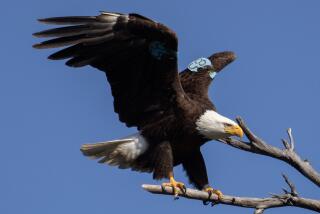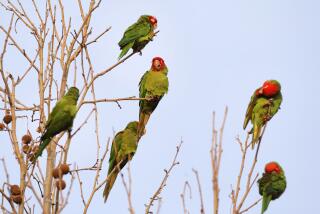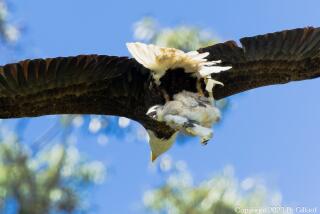BREEDING BIRDS: AMERICAN KESTREL (Falco sparverius)
- Share via
Description: Is a swallow-like falcon, the size of a jay; formerly called Sparrow Hawk. Has russet back and tail with double black stripes on white face; translucent spots on trailing edge of wings are visible from below; males have blue-gray wing coverts. Habitat: Found in open country with scattered trees, near highways and in cities; often perch on telephone wires. Diet: Feed on insects, reptiles and small mammals, hovering over prey before plunging; caches invertebrates, usually in grass clumps. Call: Shrill killy killy killy or a rapid klee klee klee. Nest: Competes with other hole-nesters for nest sites; uses little, if any, nesting material; often uses same nest for second brood. Eggs: Occasionally lavender; usually white/pinkish-white, marked with browns; less than one inch long. Conservation: Kestrels will readily uses nest boxes when they are provided. Breeding bird atlas: To report bird breeding activity in your neighborhood, or to get information on the breeding bird atlas, call Sea and Sage Audubon Society members Sylvia Gallagher, (714) 962-8990, or Nancy Kenyon, (714) 786-3160. Note: Map is divided into 5-kilometer squares so that Audubon Society volunteers can more easily survey areas on a regular basis. Sources: Sea and Sage Audubon Society; “The Birder’s Handbook,” Ehrlich, Dobkin and Wheye, Fireside Books (1988); “Field Guide to the Birds of North America,” National Geographic Society (1987); “Birds of Southern California: Status and Distribution,” Garrett and Dunn, Los Angeles Audubon Society (1981). Indicates 5-kilometer-square areas where breeding activity has been confirmed.
More to Read
Sign up for The Wild
We’ll help you find the best places to hike, bike and run, as well as the perfect silent spots for meditation and yoga.
You may occasionally receive promotional content from the Los Angeles Times.






